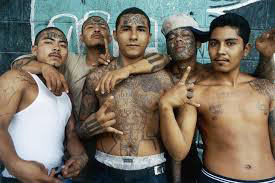Guatemala President Otto Perez Molina blamed high levels of violence in January on rivalries between street gangs MS13 and Barrio 18, revealing the impact of these groups not just in El Salvador and Honduras, but Guatemala as well.
Violent death statistics rose to 488 in January 2015 from 484 in the same month last year, Prensa Libre reported. Perez said that 40 percent of January’s violence was due to conflict between gangs.
MS13 and Barrio 18 are Guatemala’s most prominent street gangs. Both groups trace their origins back to Los Angeles but now operate mainly in the Northern Triangle of Guatemala, El Salvador and Honduras. In Guatemala the gangs mainly focus on extortion but are also involved in kidnapping and bank robberies, according to the nation’s anti-gang unit.
January’s statistics come despite the president’s claimed security achievements during his first three years in office and his promise to make 2015 Guatemala’s “year of non-violence.” Criminal violence claimed 5,924 lives in 2014, a separate Prensa Libre report claimed.
InSight Crime Analysis
As general elections approach this year, Perez is likely hoping to protect the political legacy of his hardline “mano dura” security strategies and the election prospects of his conservative Patriot Party. While Perez may be seeking to divert some blame for the increase in violence, the gangs’ influence in Guatemala and other Central American countries, is undeniable.
Within Guatemala the groups are linked to some 30 percent of the nation’s extortion cases. In Honduras MS13 and Barrio 18’s violent struggle for the city of San Pedro Sula have contributed to its ranking as the world’s murder capital four years in a row. Meanwhile the disintegration of El Salvador’s 2012 gang truce was widely considered the primary reason for rising homicide rates there in 2014.
SEE ALSO: Profile of Mara Salvatrucha (MS13)
The real question is whether these two groups, which have transnational presence, have any kind of centralized, cross-border leadership. While instances of cross-border cooperation have been documented, gang leaders’ abilities to coordinate and control actions regionally or even on a national level, are debatable. The gangs may be transnational criminal organizations — as the US Department of Treasury labeled MS13 in 2012 — but appear to operate more under a franchise model than as a coherent and structured organization.
A new gang truce recently announced in El Salvador may be an opportunity to see how well MS13 and Barrio 18 exercise control over their disparate cliques. It remains to be seen if this truce will be respected throughout El Salvador, let alone in Honduras and Guatemala.
Correction: An earlier version of this article reported that Perez said violence increased 40 percent in January. He said that 40 percent of violence in January was due to conflict between gangs.

